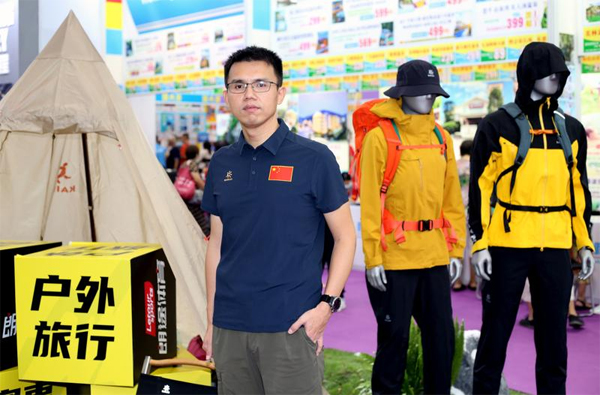Greater Bay Area holds promise for winter sports

Yang Long, business operations vice-president of Guangzhou Kailas Sports Product, at the Global Snow Tourism Forum in Guangzhou. [Photo by PARKER ZHENG / CHINA DAILY]
Businessman in Guangdong sees great market potential of ice and snow sports
Riding the nation's wave of winter sports fever, the Guangdong-Hong Kong-Macao Greater Bay Area has huge potential to become a promising and emerging market for ice and snow sports and related tourism, according to an outdoor sports gear provider based in Guangzhou, Guangdong province.
Since China won the bid to host the 2022 Winter Olympics in 2015, winter sports and tourism have gained increasing popularity in the Greater Bay Area, said Yang Long, business operations vice-president of Guangzhou Kailas Sports Product.
Yang spoke to China Daily during the Global Snow Tourism Forum held in Guangzhou on Sept 10 as part of the 2021 China (Guangdong) International Tourism Industry EXPO.
As a leading sports gear producer in China, Kailas - one of the organizers of the forum - specializes in winter sports gear and mountain climbing equipment, and began producing skiing equipment in 2015.
The company's sales of skiing equipment in the past few years, with the exception of last year when the COVID-19 pandemic struck, have grown by 20 percent in the Greater Bay Area.
Most of the company's clients are new to the sport, and require a full set of skiing equipment, including a suit, snow boots, gloves and hats. Some high-end ski suits and outdoor jackets are also in demand, according to Yang.
He expects the demand for skiing gear to rise as the sport becomes more popular, and there's a need to upgrade the equipment to meet the region's consumption potential.
Residents in the Greater Bay Area, especially teenagers, have become increasingly enthusiastic about joining winter sports camps and training activities organized by Kailas.
In winter, the company frequently organizes tours for youngsters in southern China to go to ski resorts in the northern cities to practice the sport. The venues include Songhua Lake in Jilin province and Chongli in Hebei province, a major venue for the 2022 Winter Olympics. Despite the distance, the activities have drawn relatively high participation from Guangdong residents.
According to a report by Ctrip and China Tourism Academy on China's ice and snow tourism consumption in 2020, Guangzhou ranked second and Shenzhen was seventh on the Chinese mainland in terms of the number of outbound tourists for ice and snow tourism. Shenzhen tourists' average consumption during the trips exceeded 6,000 yuan ($930).
Besides traveling to the north, indoor winter sports venues in the Greater Bay Area have been drawing enthusiasts. Guangzhou's Sunac Snow Park went into operation in 2019, becoming the biggest indoor ski field in southern China. Yang said despite the high maintenance costs, the park has performed well and is popular among local residents.
Shenzhen also has a ski resort at its theme park, Window of the World. Currently, Guangdong has 20 indoor ice rinks with a total area of 20,000 square meters.
Compared with other sports, ice and snow sports, such as skiing, ice skating, and snow mountain climbing, have a high threshold for participants with regard to either skill or costs, said Yang.
Generally speaking, as a southern region on the mainland, the Greater Bay Area's acceptance and recognition of ice and snow sports is still limited. Many people even don't know how to pick up the sport, he said.
To expand the market in this area, he urged local governments and industry players to do more to publicize winter sports and promote related tourism destinations.



 Print
Print Mail
Mail

